The KVVAK trip to China - Travel Diary by Alice Rijkels
Wednesday October 26, 2016 - Jingdezhen
The temperature is subtropical again this morning; the air is humid and hot. Carl has no time to stand on his head, so I do it on my own: a Chinese gentleman stops when he sees me upside down in the hallway. Calmly, he observes what I am doing; I wave with my toes and mumble “Ni Hao”.
At breakfast I meet with Michael and Shawn (Xun) Zhang again. Yesterday evening, so Michael tells us, he went out into the environment to take many pictures. Today, neither he nor Shawn will have much time for sight seeing; they need to travel back to the U.S in two days.
For today, Truke has decided to take a break from the program; the rest of us will first go to the Jingdezhen China Ceramics Museum.
Wednesday October 26, 2016
Jingdezhen
Wednesday October 26, 2016 - Jingdezhen
The temperature is subtropical again this morning; the air is humid and hot. Carl has no time to stand on his head, so I do it on my own: a Chinese gentleman stops when he sees me upside down in the hallway. Calmly, he observes what I am doing; I wave with my toes and mumble “Ni Hao”.
At breakfast I meet with Michael and Shawn (Xun) Zhang again. Yesterday evening, so Michael tells us, he went out into the environment to take many pictures. Today, neither he nor Shawn will have much time for sight seeing; they need to travel back to the U.S in two days.
For today, Truke has decided to take a break from the program; the rest of us will first go to the Jingdezhen China Ceramics Museum.

At around 9:30 we arrive there with the bus. The architecture of the building is very commanding, the entrance hall has the height of 4 floors. The building has the shape of a horse-shoe kiln. It has a cylindrical form with grey and white marmor stone at the inside.
The echo is interesting here: the sound flows through the open spaces as if it is carried by a strong wind at sea – it sounds like a mix of children’s voices and soft Chinese music.
White porcelain is what Jingdezhen is famous for. (Of course, having visited Dehua last week we know, that Dehua white porcelain is of great quality too.) In the entrance hall, sixteen China bulls in white porcelain are on display - made by the artist Zhu Legeng. The porcelain collection of the museum spans all ages of Jingdezhen’s porcelain production: celadons and ceramics from all periods and regions. The information boards In the exhibition rooms are written in Chinese: nevertheless, we manage to roughly guess the time of production for the objects. At the base of the porcelain we can sometimes check the reign mark. Most of the names of the modern time porcelain creators are shown in characters; but their portraits are shown on various photo’s on the wall of the museum, so I take pictures, to ensure I have their info. One day I may be lucky and run into a Chinese friend who will assist me with the translation!
I go and take a look at the exposition called: “The ceramics exhibition of masters of famous kilns”. On the ground floor wonderful export porcelain is being exhibited: many plates, bowls and vases are on show. Some of the plates such as the General Duff plate I know from the Rijksmuseum. It was produced in Jingdezhen during the Yongzheng (1723 -1735 AD) era. The plate shows Governor-General Duiven (of the VOC, the East Indian Company) walking outside with


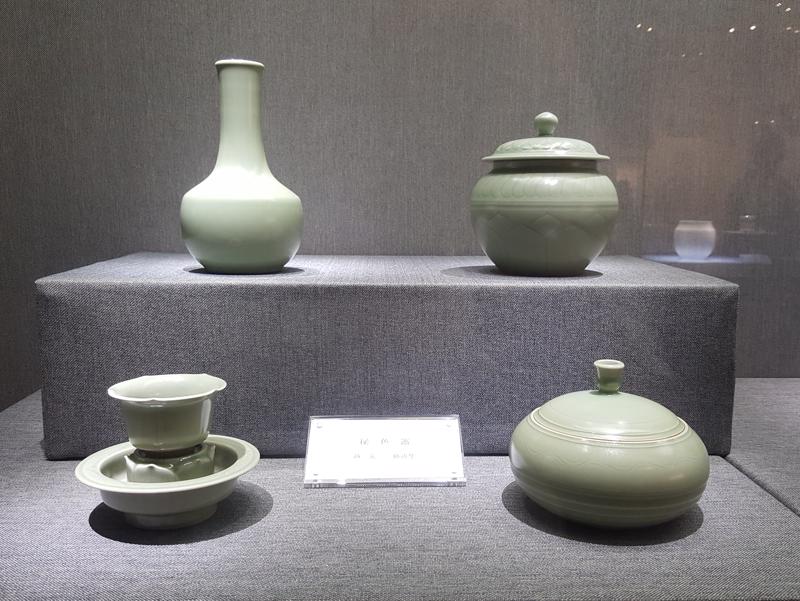


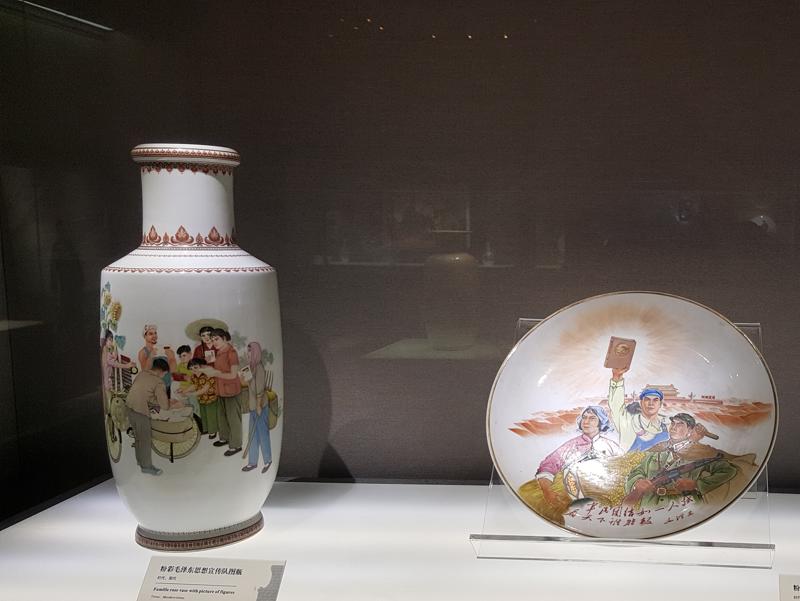
his wife; their dog walks in front of them. The couple walks arm-in-arm, in expensive clothing; they are surrounded by trees and leaves in warm colors. The Governor wears red trousers, and a dark blue coat with golden rims and decoration. His wife is dressed in a long gown with glowing red and gold. The plate is heavily decorated: red, orange, gold and blue enamels light up from the plate. What did the potters think of this couple and their dog?
On the first floor, I gaze at modern ceramics. Brilliant. There is certainly a future for modern porcelain!
The stairs in this building seem to copy a dragon kiln which has a steep slope against the mountain. (For a good explanation on kiln types see the website of the Osaka Museum of Oriental Ceramics: http://www.moco.or.jp/en/intro/guidance/ )
There is another exposition, of export porcelain. A massive collection of all types of objects can be found here. An information board informs us, that the history of the production and trade of export porcelain - defined in broad terms – covers the period from the Tang to the Qing Dynasties.
The Yongzheng and Kangxi porcelain is on show on the top floor of the huge museum. Some objects from the Qing dynasty are here as well, and
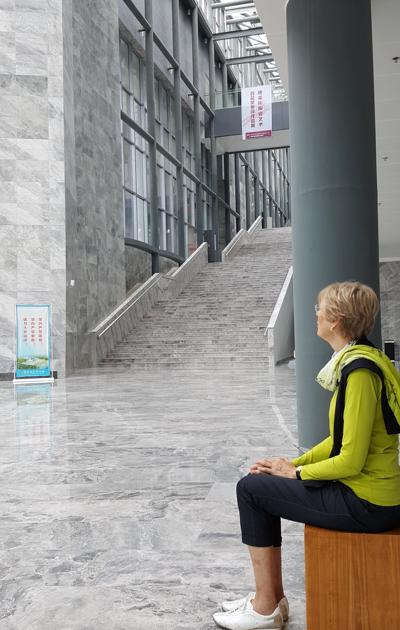
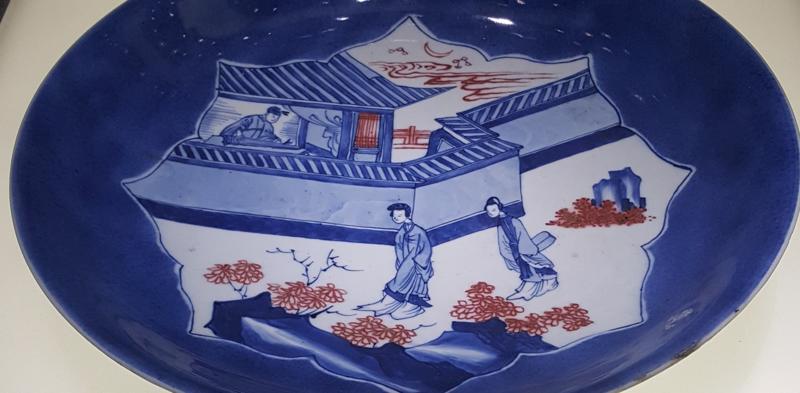


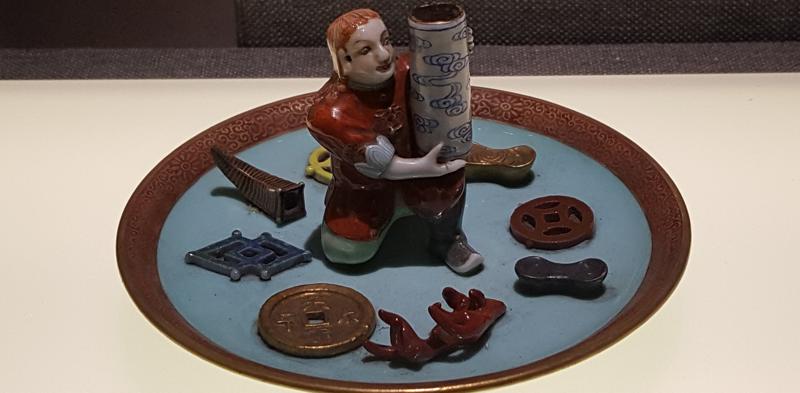
porcelain of the 20th century. There is also a bookstore; again it is a a bit frustrating that there are many, many books, but only in Chinese. I do find two small guides on Yuan and Ming porcelain in English though, with good explanations; and in those there is a chapter called “Auction prices, estimated and real”. The guides are from 2002. I buy them at a very low price .
Around lunchtime we meet our group in the huge hall of the museum.
Then the bus drives us to a conference center that Christine already knows from a conference she attended here once. We follow her up the stairs of the pompous hall. Along the cupola we walk until we hit the lunch room. Sitting at the round table, we exchange our impressions of the porcelains we have admired. Christine tells us about the conference she attended once in this building. Memories… she has written so many articles; she inspires us with her knowledge. Her thesis will be about Dutch trade porcelain under the guidance of professor Anne Gerritsen of Leyden University. I make a note to reread some of her articles and books, such as the “Ceramic on the Witte Leeuw” and articles on Kraak porcelain.
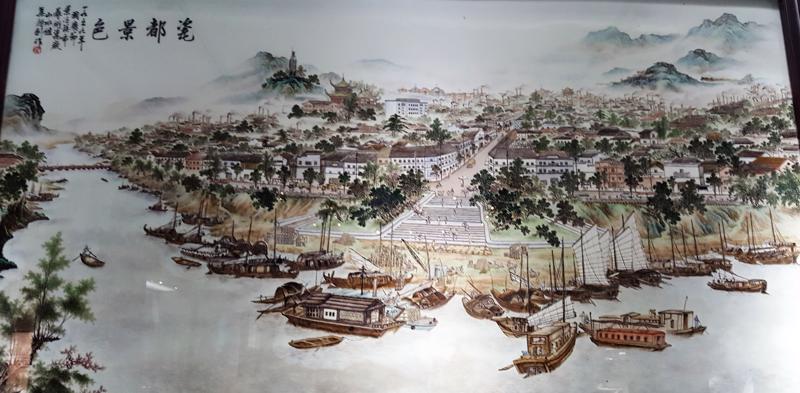
Waiting for Peter and the driver after lunch, Carl and Ting-tiang are dozing off on a pompous couch; they look like two literati on a Chinese painting – or just two Chinese friends on a bench in a Pavilion… when they wake up they may start a game of chess. But there is Peter already; he wears his black “Superman” t-shirt - which is appropriate, as he looks after us so well.
The bus takes us to the Jingdezhen Ceramics Historical Museum (Tao Ci Li Shi Guang Fa Yue Lan Qu) also named Jingdezhen Ancient Kiln Folk Customs Museum (Gu Yao). This museum is located on the outskirts of Jingdezhen.
For information refer to:
http://www.chinaguyao.com/english/KilnsReburn/2012-08-09/35.html
Located at the the beautiful Maple Hill to the west of Jingdezhen, the ceramic historical Expo Zone is open to the public. Visitors may learn about Jingdezhen’s ceramic history and also enjoy the Ancient Kilns (ancient kilns of past dynasties: the Jingdezhen kiln of Qing Dynasty, Gourd kiln of Ming Dynasty, Steamed bun kiln of Yuan Dynasty, Dragon Kiln of Song Dynasty) scattered around throughout the expo zone, which covers an area of 830,000 square meters.
Among the ancient kiln factories is the famous Chicken Egg kiln from the Ming. Also there is the Qing period Jingdezhen kiln, which is still active today; this kiln even has two storeys for firing the porcelain. In the ancient kiln workshop, artists can be admired making ceramics manually: they make copies of ancient porcelain. On the museum grounds one finds the ceramic Stele Corridor; a gallery for paintings and calligraphy; the founder’s Temple; the Queen Mother’s Temple; the temple of Wind & Fire Immortality.
There is also a compound of houses of the Qing Dynasty (1644-1911 AD). In these houses, there is an exhibition of the ceramic history of Jingdezhen; and an exhibition of calligraphy and paintings. Then, in the building of folk customs, there is Jingdezhen folk art to be admired. In the exposition zone traditional ceramic handcraft demonstrations are going on continuously.
The exposition zone has a natural scenery, surrounded by hills , characterized by luxuriant forestry, lakes, rows of ceramic workshops, surrounded by rare flower beds and bamboo groves. The harmonization of the scene is prevailing. This is a world-famous scenic spot for tourists.
We enter the shop of the museum, it has many wonderful books on offer – but again, only in Chinese. Wai Lan finds sets of cards for a small price; I buy “life portraits of Yinzhen”. This set of cards pictures the emperor Yongzheng engaged in all types of activities such as meditating in a grotto, playing music on the river bank, painting and reading.
Peter calls out to us: we have to hurry up as an open air concert will be performed under the pagoda. So, at high speed we cross through the lush green park along the lake and arrive at a terrace where many people are gathered. We find good natural seats on the stone steps on the front row. As the terrace faces the pavilion where the performance will be given, our view on the stage is perfect.
A chorus group of angelic looking creatures in light blue, flowing silk dresses enters the stage. They sing and play music on classic instruments: the rhythm is soothing, the leaves on the trees around us seem to drift on the breeze of the sound. I think of Max Pam’s “Chinese brieven”, with letters written to him by Rik Schipper, the
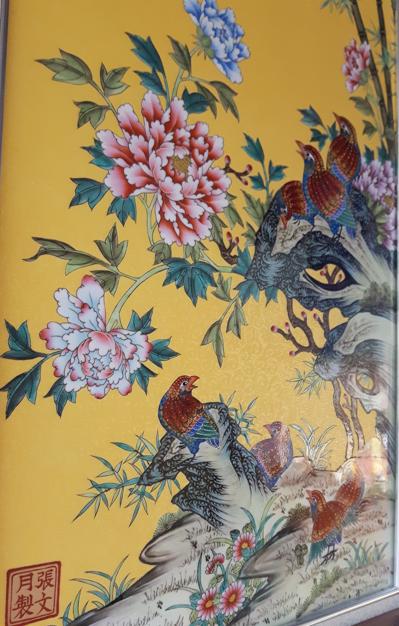

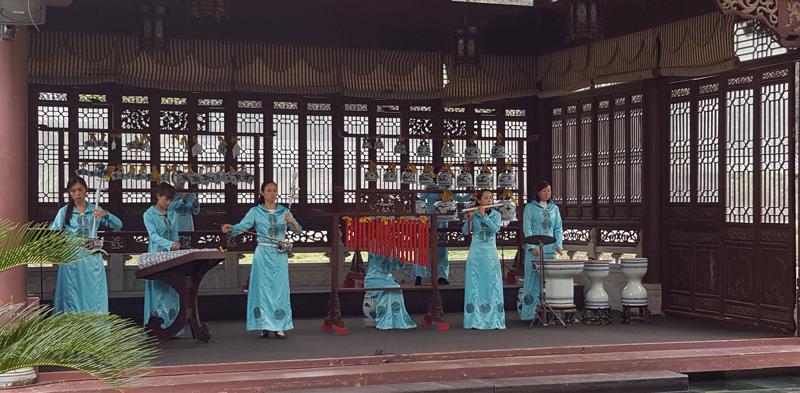


famous French Tao scholar.
“Dear Max,
Relax! Go with the flow. Follow nature. Be spontaneous. This idea is the source for Taoist thinking. Go against the flow sounds so interesting, but won’t it just impact/ tire you terribly? In China being original is not admired a lot. Why are we Westerners so different?”
The soothing live concerto captivates us for its full length of about 30 minutes.
After this lovely performance, we pass through an alley where porcelain painters decorate white pots and jars; the painting of the pots goes on while we pass along the stalls; biscuit is made here for firing porcelain; clay refinement is practiced; The pots and jars are prepared with under-glaze blue; the brushed decoration looks perfect already. Huge vases are being decorated with flowers against bright yellow backgrounds. We pass a lady who is famous as she is blind and does not hear well, but makes the most brilliant decorations with beautiful flowers and settings. It touches me how she works in this condition, the result is so good…flowers in different colors, birds and butterflies. The birds are smaller than the peonies (it has the same picture as the Yongzheng export porcelain plate from the Dutch Menkemaborg, which I received my mother-in-law).
In the workshops, Sam speaks with a porcelain maker about Woucai and Doucai: they gesture intensively, speak the same language, even though they do not. We then follow Peter into the zone where the kilns are located. Near the Chen kiln a film on porcelain production is shown in an exposition room. The melting heat gets to me, it must be the combination of the people who work so hard here and the beauty of the objects which has a dizzying effect on me.
Attached on the wall is a picture of the famous CCTV historian and “lecture room speaker” Mr. Yan Chongnian: he lights fire of the Zhen Qing kiln with a stick. This kiln is the world’s largest wood fire kiln.
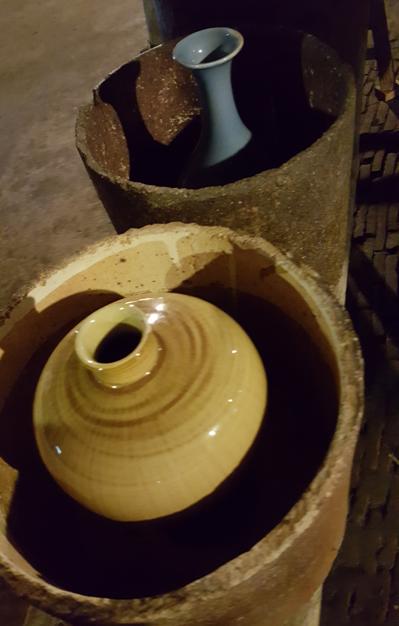
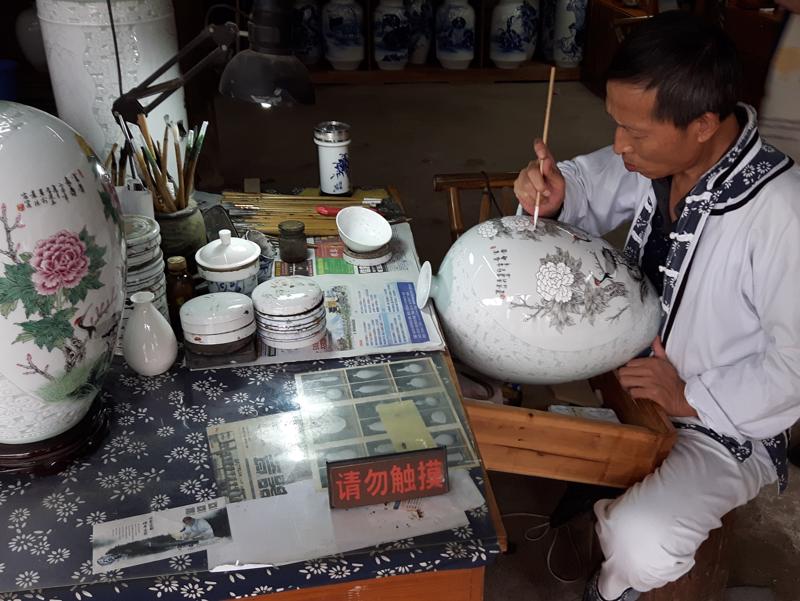
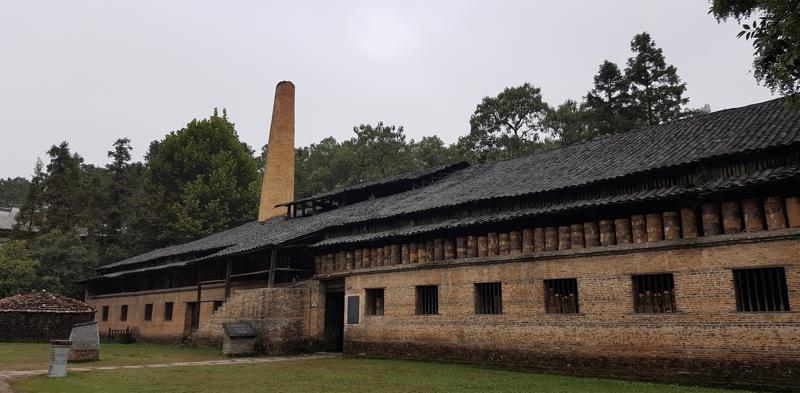
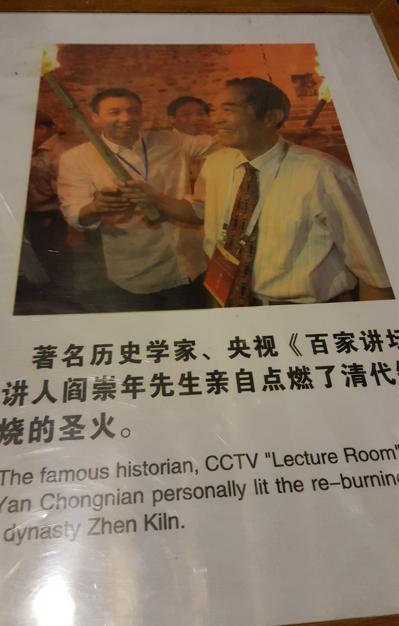
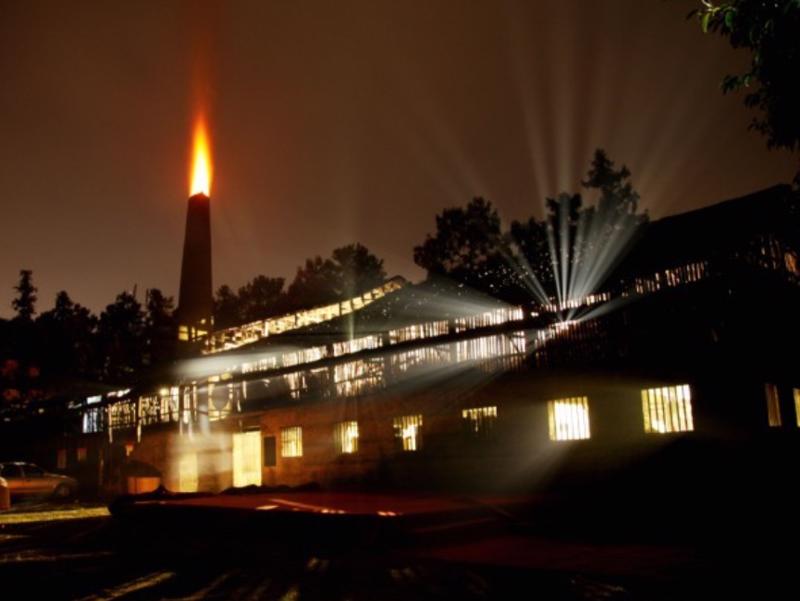
I look want to show this picture to the others, but I seem to have lost the group. Maybe, after the heavy lunch I have become too slow to follow them; I feel like lying in the grass here in the park like a Chinese poet, but then I hear Peter’s voice somewhere in the woods.
I float back into the group. We see a kiln from the Song, a chicken kiln and some others.
On our way back, a massive statue of a muscled man celebrates the Revolution. Near the parking lot, we come aceoss a fountain with all the animals of the Chinese Zodiac Peter is making a lot of noise and jumping around points to the animals of the Zodiac. “You are a rooster” I shout at him and he makes big jumps and happily agrees he is one, he bows, impressed that I guessed his Zodiac symbol correctly. I shoot a picture of our great guide showing the peace sign and the radiant lady Bente looking into the camera as well.
The Jingdezhen Ancient Folk Kiln Museum is next on the program. It is of a much smaller size, but very precious objects are exhibited in

the building. The museum is located in the reserve of the Hu Tian Kiln Relics – a National Cultural Heritage Conservation site. This museum collects relics from the Jingdezhen folk kilns from the Five Dynasties up to the China Republic. This Hu Tian kiln was the folk kiln with the largest production in Jingdezhen.
The small exhibition spaces with well-designed wares generate our respect for the makers. Lovely blue-and-whites were made at this location. The Hu Tian kiln started in the Five Dynasties period; the kiln reached a period of great prosperity during the Song and Yuan time and then perished during the Ming. Typical ceramics during the Five Dynasties are white porcelain. Also, during the Song Celadons and White porcelains which represent the highest level of ceramic production were made at Hu Tian. Egg-white glazes were fired during the Yuan, though at this time also valuable under glaze red and under glaze white-and-blue were produced. These Yuan porcelains show decoration typical of that era. I enjoy this small and relatively simple museum: the spaces are neatly done and the wares exposed are of great form and color. Especially the globular Song jar, with a soft white color is very serene, the form and color go very well together; the celadons with a butter soft looking glaze are of good quality as well. There is a kiln entry dug out on the floor of the museum. A lot of the descriptions on the objects are again in Chinese characters; it is good they also have a folder in English available.
This museum is a treasure box…, but the group drags me out of it after 20 minutes. The bus drives us back to the hotel to pick up Truke: all relaxed with a big smile she climbs into our bus.
We will now go to the famous Porcelain workshop named Jiang-yao. We are amazed to find many decorators sitting at long tables

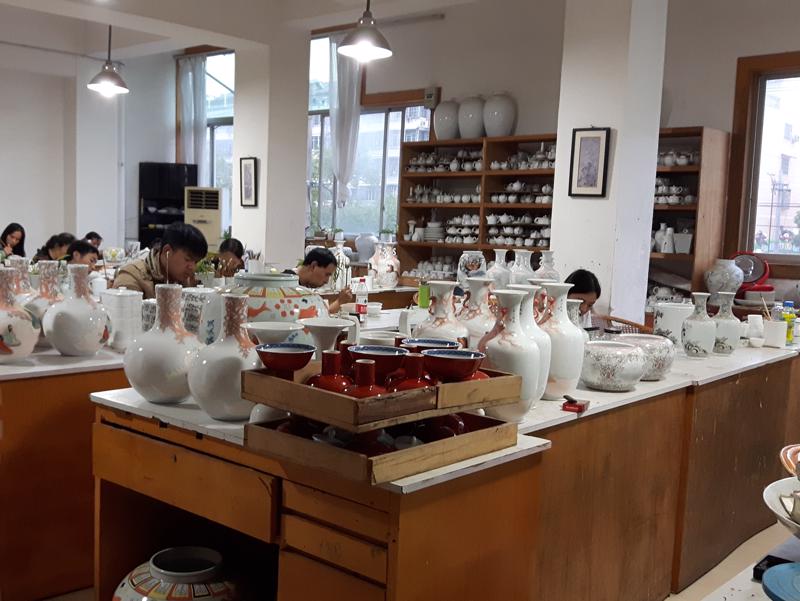
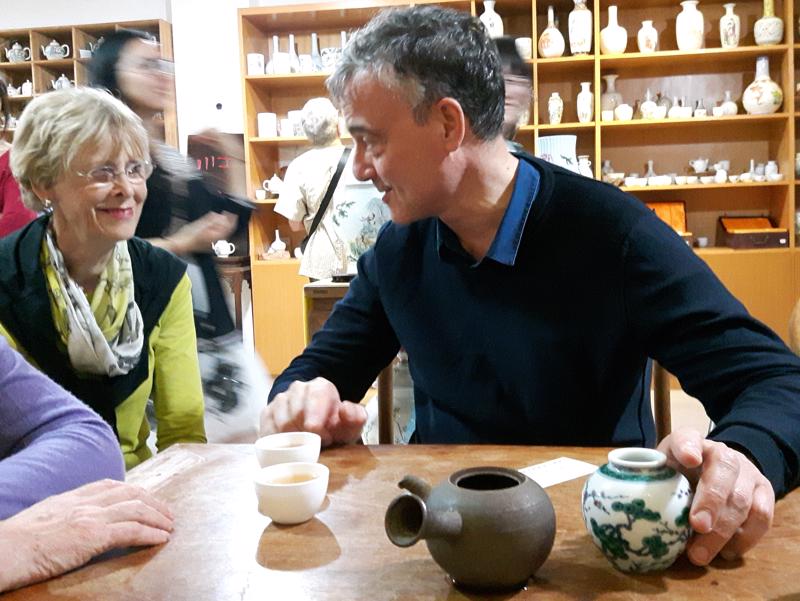

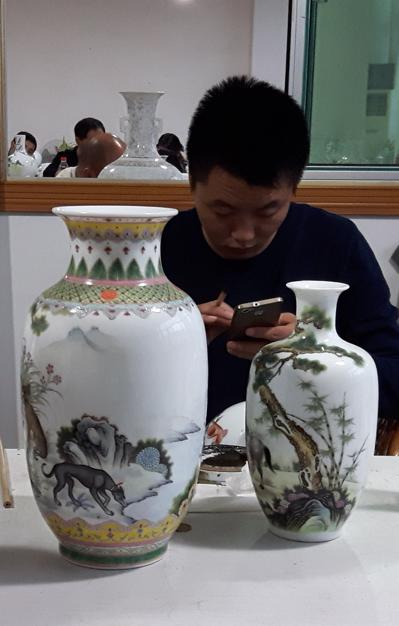
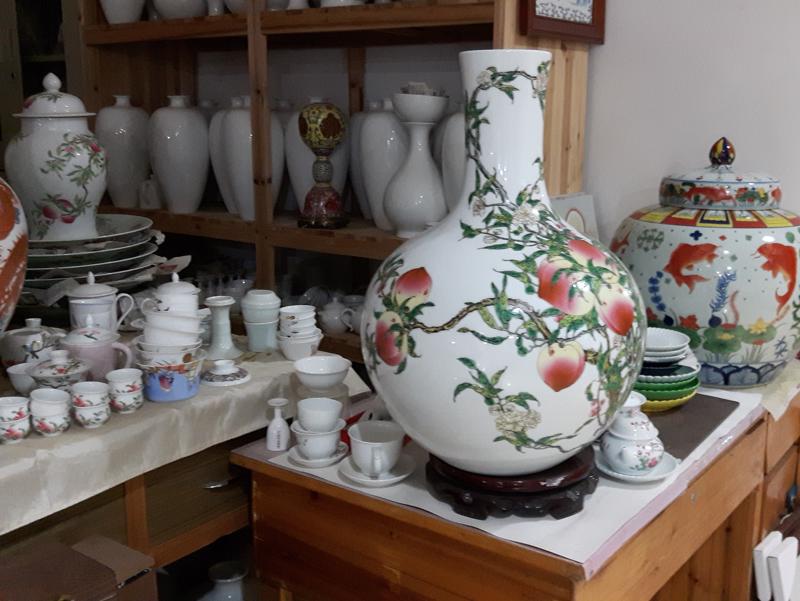
painting animals, butterflies, plants, palms and flowers. The workshop is lead by Jiang Xunqing. He is a porcelain artist who has exhibits his art in museums all over the world. The production and decoration of the porcelain is done in the style of Ming and Qing, but not a copy of it. We see all jars, plates and bowls created by… him and his hardworking team. His recent work is on show: we admire ancient types of decoration with innovative design…it is all very beautiful. The workplace is pictured in following short video: http://en.sinovision.net/jiang-yao-porcelain-art-exhibition/ .
Porcelain is everywhere we look in the workplace: white unfinished jars, plates, cups. All the young decorators seem to have their own specialty – it looks like hard and tedious precision work to decorate all the wares. Lots of the youngsters have a smartphone and listen to music while working. The group gets an introduction about the shop and tea is served. Sam and Marion buy vases, Christine and Truke sip the tea and discuss the beauty of it all. I pick up a small globular jar, blue-and-white plants and flowers on it, as can be seen in 17th century Dutch still-life paintings. The jar has a great glaze, it looks calm and strong, I take it to Carl, Bente and Truke, who are seated with tea at the table, they study my choice: you want to buy blue-and-white jar?
Carl has the final word: I should take a colored jar as colored wares are what Jiang-yao is famous for. So I pick a similar type of globular jar, but now with colored plants and with a Yongzheng mark on it. The jar fits in the cusp of my hand. Painted on it are “the three friends of winter” (in Chinese: “shochikubai”) being plum, pine and bamboo - pictured together this means Lao Tse, Buddha and Confucius together! Bente and Truke notice there are two nearly the same jars with the three friends of winter on it. I take those two to the table and Carl checks colors and lines of these two doucai (blue under glaze, filled in with dark moss green and purplish red over glaze decoration) jars. Carl finds on one of the jars a dot on a line…so he advises me to take the other jar; the ladies agree. After negotiating I get the jar for 1700 yuan, a good price. The jar gets wrapped in a square wooden box. Then I realize with a shock that - in the evening, in the village of Jinkeng last Monday, -when it was so hot and the food so great and Sam was going to give a lecture - Xunqing was there, at our table as well. He even sat next to me for a short while, his eyes looking so wise; he had an artistic expression and a small white beard. Peter told me at that time, that we would go and visit his workshop in a couple of days, in Jingdezhen… but I had no idea then, that Jiang Xunqing is one of China’s top porcelain producers. So I had missed out on having a picture taken of this great artist sitting next to me at a dinner table in Jinkeng!
After a great time at the workplace we follow Peter out onto the street and then we climb the stairs of a restaurant. We are invited to this restaurant by the shop owners of Jiang Xunqing’s porcelain shop. Leafy green vegetables are spread in a long row on the stone railing outside in front of the restaurant door. The heat is enormous, also in
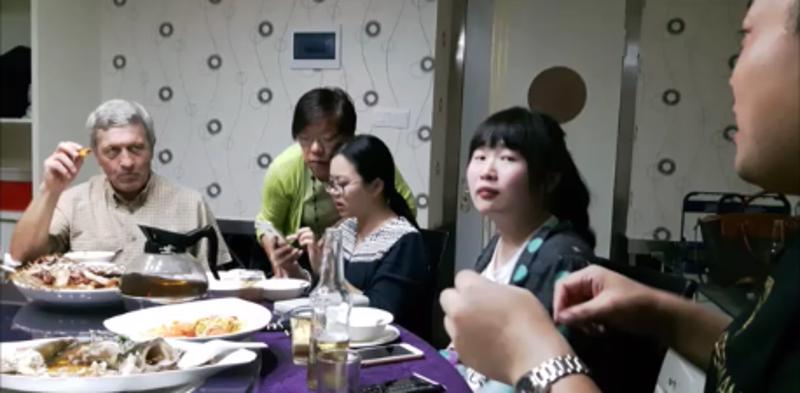
the private room where we are seated... but the food is tasty and we thank the shop owners heartily. For some reason beer is served, which I politely drink. Peter vividly talks to Sam; Carl and Bente are in deep conversation: discussing a Head of the British Museum going to the US for an adventurous relocation. Sam calls out over the table to Peter to discuss wares; Christine, Marion, Truke, Wai Lan, Ting-tiang and two ladies of the shop are discussing porcelain… we are all so impressed with their wares. Once more our spirits are lifted into the heaven of art and Chinese porcelain.
When we walk out, a baby, resting on an arm of a passerby in the restaurant blinks an eye. I get a selfie request from the mother. She seems to be on a family outing. The baby is as cute as can be, the group and the baby gaze at each other in awe.
On our way back to the Manju hotel Sam and Marion leave for an evening meeting with a director of collections. Sam will do his presentation.
While we get out of the bus at the hotel, Ting-tiang asks our group to come over to the Lobby in an hour as there is a small party organized for Sam and Marion.
Back in my room I hear from Pieter that he is reading the Gnostic Nag

Hammadi scriptures. The new soft globular jar with the three friends I place on my bedside table. The three friends on it represent what everyone needs: a mixture of beliefs to find a path in life.
The wine we enjoy together in the lobby is good. After the small party we happily stroll back through the long corridors of the hotel with Carl and Truke.
Tomorrow we will have a day without a group program: we can do as we like. Tomorrow in the evening we will fly to Hangzhou. It is the old capital of the Southern Song. Today it is the capital and most populous city of Zhejiang Province in east China. Truke asks Carl what his plans are, he states he will have a “matina grassa”, which means an “easy morning”. I make fun of myself about not having been able to write notes for days now and it is already 11:00 PM! Tea I take in my room; jotting down scribbles of 3 days ago in my note book; holding my jar; listening to music on my smartphone; packing my bags for it will be the last day tomorrow in Jingdezhen…falling asleep.
Pictures in this chapter (first to last; per line left to right):
1. The hall of the Jingdezhen Ceramics museum
2. General Duff plate, Yongzheng reign of Qing Dynasty – export ware
3. China bulls, sculpture by Zhu Legeng
4. Modern celadons made by Jingdezhen artists
5. Modern porcelain artist (names only in Chinese – WIP)
6. Red enamelled ware, Jingdezhen – export ware
7. Bente at the Jingdezhen Ceramics Museum
8. Republic of China porcelain
9. Blue glaze plate with underglaze red picture of figures in the Romance of the West Chamber, Kangxi reign of the Qing Dynasty
10. Famille rose plate with peacock and peony pattern, Yongzheng reign of Qing Dynasty
11. Green glaze vessel carved with cloud, Kangxi reign of Qing Dynasty
12. Famille roze censer in shape of figure on green ground, Qianlong reign of Qing Dynasty
13. Jingdezhen shown in porcelain
14. Decoration of yellow vase by artists at the Jingdezhen Ceramics Historical Museum
15. Chinese landscape design at the Jingdezhen Ceramics Historical Museum
16. Performance at the Jingdezhen Ceramics Historical Museum
17. Vase made by artists at the Jingdezhen Ceramics Historical Museum
18. Bente, Carl, Ting-tiang, Wai Lan and Christine at the Performance at the Jingdezhen Ceramics Historical Museum
19. Wares (in saggars) from the kiln at the Jingdezhen Ceramics Historical Museum
20. Artist decorating in overglaze at the Jingdezhen Ceramics Historical Museum
21. The Zheng Kiln, the largest wood fire kiln in the world, in passive mode
22. Yan Chongnian lights the ancient Zheng kiln
23. The Zheng Kiln, the largest wood fire kiln in the world, firing porcelain
24. Peter, our guide and Bente at the fountain with Zodiacal signs at the Jingdezhen Ceramics Historical Museum
25. Vase and plate at the Jiang-yao workshop of artist Jiang Xunqing, Jingdezhen
26. Artists decorating porcelain at the Jiang-yao workshop of artist Jiang Xunqing , Jingdezhen
27. Bente and Carl at the Jiang-yao workshop of artist Jiang Xunqing, Jingdezhen
28. Decoration at the Jiang-yao workshop of artist Jiang Xunqing, Jingdezhen
29. Modern times at the Jiang-yao workshop of artist Jiang Xunqing, Jingdezhen
30. Porcelain from the Jiang-yao workshop, Jingdezhen
31. Sam, Wai Lan, the 2 Jing-yao directors (who invited us for dinner near the Jing-yao gallery), Peter
32. Marion, Truke and Ting-tiang at the dinner table with great food in great company!
33. Poetry and painting at the Jingdezhen Ceramics museum.
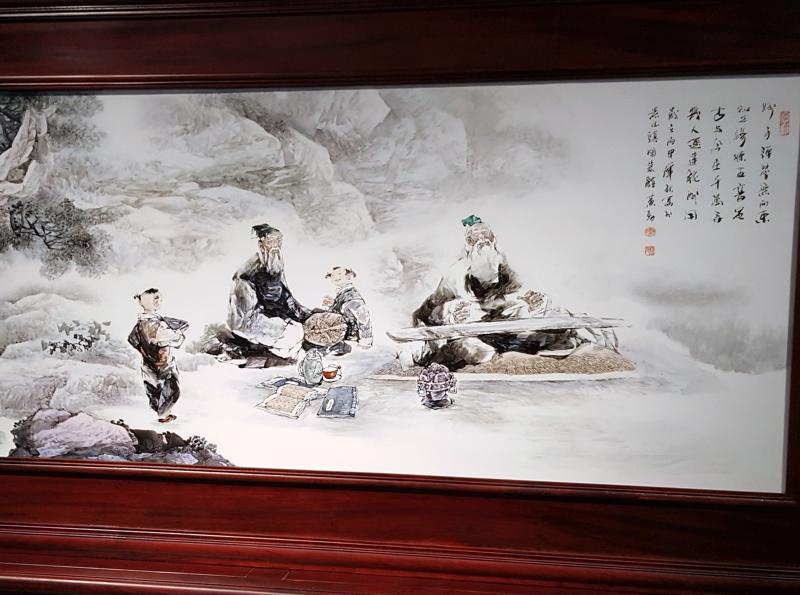
1.
Introduction
2.
Saturday October 15, 2016
3.
Sunday October 16, 2016
4.
Monday October 17, 2016
5.
Tuesday October 18, 2016
6.
Wednesday October 19, 2016
7.
Thursday October 20, 2016
8.
Friday October 21, 2016
9.
Saturday October 22, 2016
10.
Sunday October 23, 2016
11.
Monday October 24, 2016
12.
Tuesday October 25, 2016
13.
Wednesday October 26, 2016
14.
Thursday October 27, 2016
15.
Friday October 28, 2016
16.
Saturday October 29, 2016
17.
Sunday October 30, 2016